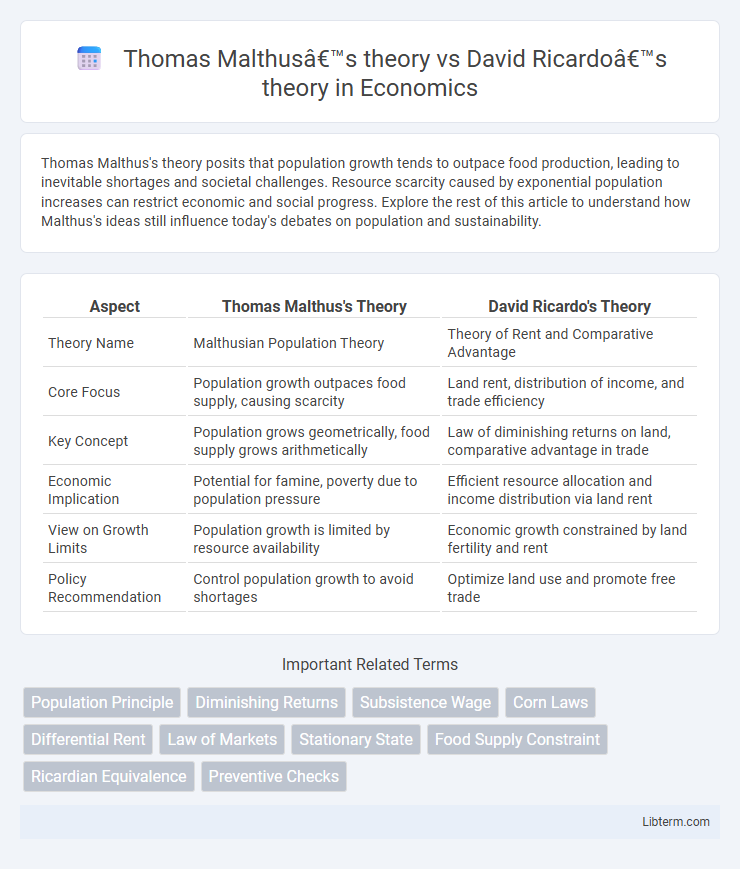Thomas Malthus's theory posits that population growth tends to outpace food production, leading to inevitable shortages and societal challenges. Resource scarcity caused by exponential population increases can restrict economic and social progress. Explore the rest of this article to understand how Malthus's ideas still influence today's debates on population and sustainability.
Table of Comparison
| Aspect | Thomas Malthus's Theory | David Ricardo's Theory |
|---|---|---|
| Theory Name | Malthusian Population Theory | Theory of Rent and Comparative Advantage |
| Core Focus | Population growth outpaces food supply, causing scarcity | Land rent, distribution of income, and trade efficiency |
| Key Concept | Population grows geometrically, food supply grows arithmetically | Law of diminishing returns on land, comparative advantage in trade |
| Economic Implication | Potential for famine, poverty due to population pressure | Efficient resource allocation and income distribution via land rent |
| View on Growth Limits | Population growth is limited by resource availability | Economic growth constrained by land fertility and rent |
| Policy Recommendation | Control population growth to avoid shortages | Optimize land use and promote free trade |
Introduction to Thomas Malthus and David Ricardo
Thomas Malthus introduced the theory emphasizing population growth outpacing food supply, leading to scarcity and societal challenges. David Ricardo developed the theory of comparative advantage and rent, highlighting the distribution of income among landowners, laborers, and capitalists in a growing economy. Both economists laid foundational principles in classical economic thought, addressing resource allocation and economic sustainability.
Overview of Malthus’s Theory of Population
Thomas Malthus's theory of population posits that population growth tends to outpace the growth of food supply, leading to inevitable shortages and increased mortality unless checked by factors such as famine, disease, or moral restraint. He argued that while population grows geometrically, food production increases only arithmetically, creating a natural limit to economic and social development. This pessimistic view contrasts with David Ricardo's theory, which emphasizes distribution of income and the law of diminishing returns in agriculture affecting rents, wages, and profits without focusing primarily on population pressure.
Core Principles of Ricardo’s Theory of Comparative Advantage
David Ricardo's theory of comparative advantage centers on the principle that nations benefit from specializing in the production of goods for which they have the lowest opportunity cost, thereby enhancing overall economic efficiency and global trade gains. This contrasts with Thomas Malthus's theory, which emphasizes population growth outpacing agricultural production, leading to resource scarcity and economic constraints. Ricardo's model prioritizes relative efficiency and mutual benefits in trade, while Malthus focuses on limits imposed by finite resources and demographic pressures.
Differences in Economic Assumptions
Thomas Malthus's theory centers on population growth outpacing food supply, assuming diminishing returns in agriculture and a natural limit to resources, which leads to periodic crises of famine and poverty. David Ricardo's theory emphasizes the law of comparative advantage and the distribution of income among landlords, capitalists, and laborers, focusing on the impact of land rent and industrial growth in a competitive market. While Malthus highlights resource scarcity and population pressure, Ricardo assumes a more dynamic economy with technological progress and trade shaping economic outcomes.
Impact on Agricultural Economics
Thomas Malthus's theory emphasized the constraints of population growth on agricultural productivity, warning that food supply would struggle to keep up with population expansion, leading to widespread scarcity and poverty. In contrast, David Ricardo's theory of rent highlighted the role of land fertility and diminishing returns, explaining how agricultural land value and production costs affect market prices and income distribution among landowners, tenants, and laborers. Both theories significantly shaped agricultural economics by addressing resource limitations and economic rent, influencing land use policies and economic modeling in agrarian contexts.
Population Growth vs. Resource Allocation
Thomas Malthus's theory emphasizes population growth outpacing food supply, leading to inevitable resource shortages and societal strain. David Ricardo's theory centers on resource allocation, particularly land rent and diminishing returns, explaining how scarce resources influence economic profits and wages. The contrast highlights Malthus's focus on demographic limits versus Ricardo's analysis of economic distribution within finite resources.
Malthusian Theory: Criticisms and Legacy
Thomas Malthus's theory of population growth posited that population increases exponentially while food production grows arithmetically, leading to inevitable scarcity and famine; critics argue this prediction underestimated technological advances in agriculture and ignored social policies that mitigate resource constraints. Despite criticisms, the Malthusian theory profoundly influenced economic thought by highlighting limits to growth and resource sustainability, shaping modern debates on population control and environmental economics. Its legacy endures in contemporary discussions on carrying capacity, food security, and the impact of population dynamics on global development.
Ricardian Theory: Influence and Limitations
David Ricardo's theory of comparative advantage significantly influenced international trade, emphasizing efficient resource allocation and specialization to maximize economic output. However, its limitations include assumptions of constant returns to scale and perfect mobility of labor and capital, which rarely hold true in real-world markets. Ricardo's model also overlooks income distribution effects and environmental constraints, which are critical in contemporary economic analysis.
Comparative Analysis: Strengths and Weaknesses
Thomas Malthus's theory highlights population growth outpacing food supply, emphasizing resource scarcity and potential famine, but it underestimates technological advancements in agriculture. David Ricardo's theory of comparative advantage focuses on the benefits of international trade, promoting specialization to increase overall economic efficiency, though it assumes factors of production are immobile and neglects distributional impacts within countries. Malthus's emphasis on environmental limits contrasts with Ricardo's market-driven trade benefits, revealing complementary insights but also exposing weaknesses in addressing long-term sustainability and equity.
Modern Relevance of Malthus and Ricardo’s Theories
Thomas Malthus's theory on population growth and resource limitations remains relevant in modern discussions on sustainability and environmental impact, highlighting concerns about overpopulation and finite natural resources. David Ricardo's theory of comparative advantage continues to underpin global trade policies by emphasizing efficient resource allocation and specialization, driving economic growth in interconnected markets. Contemporary economic challenges integrate Malthusian constraints with Ricardo's trade principles to balance population pressures and international economic development.
Thomas Malthus’s theory Infographic

 libterm.com
libterm.com